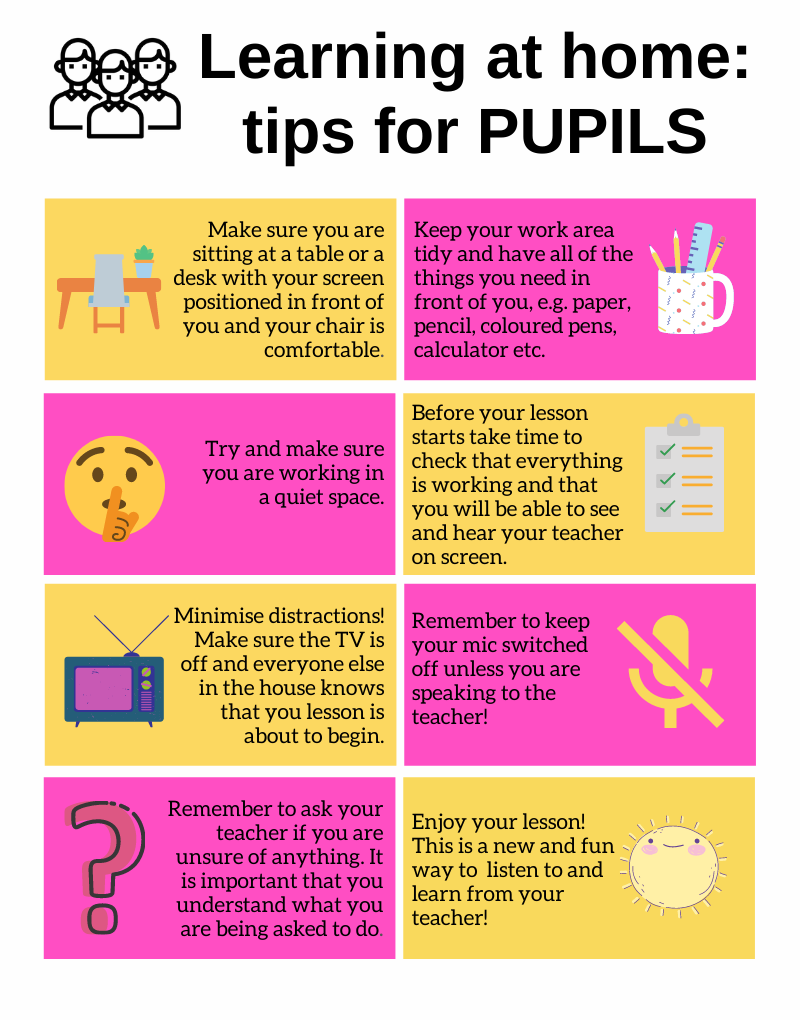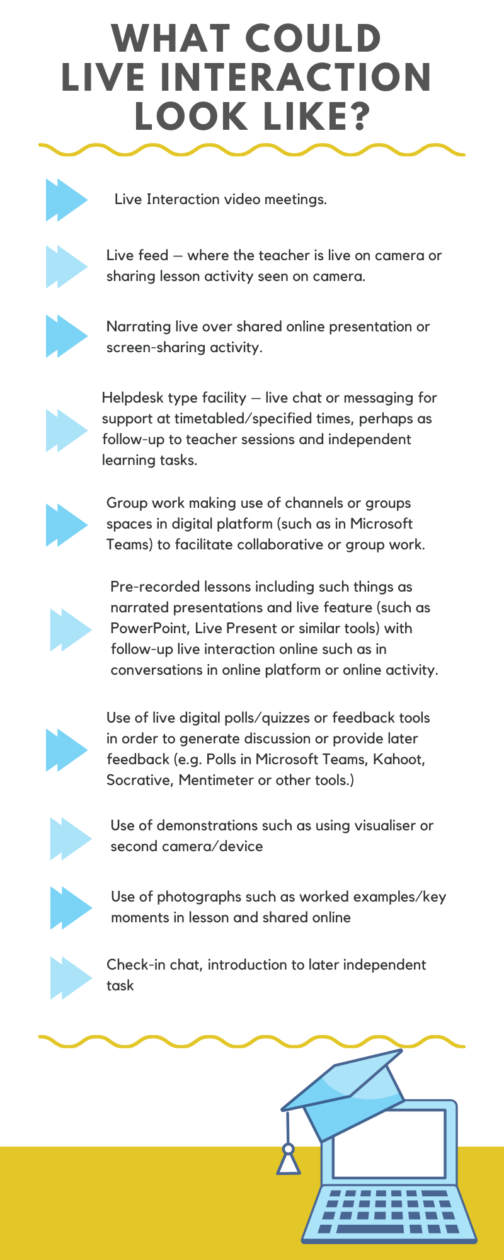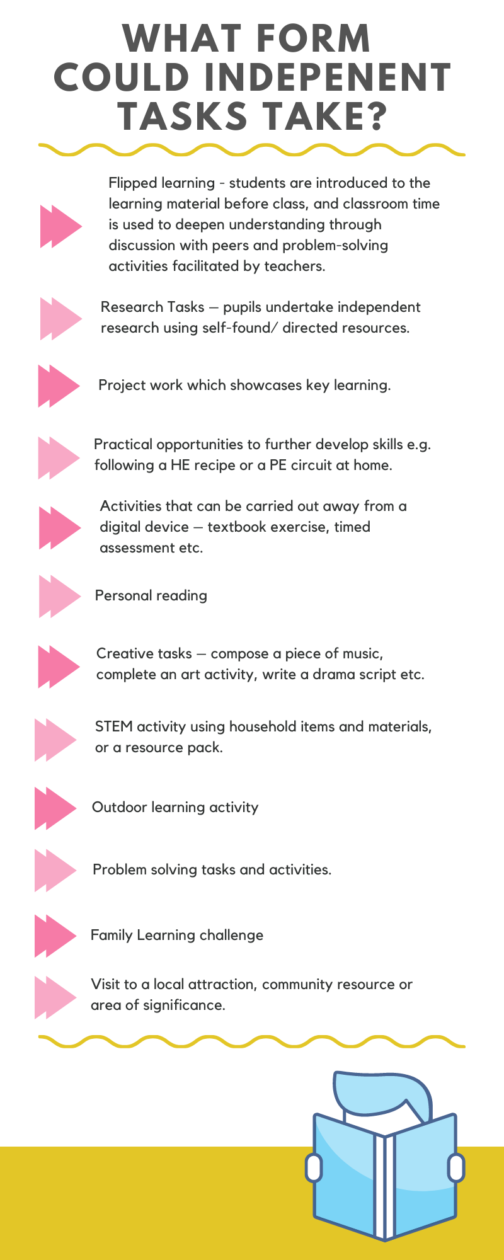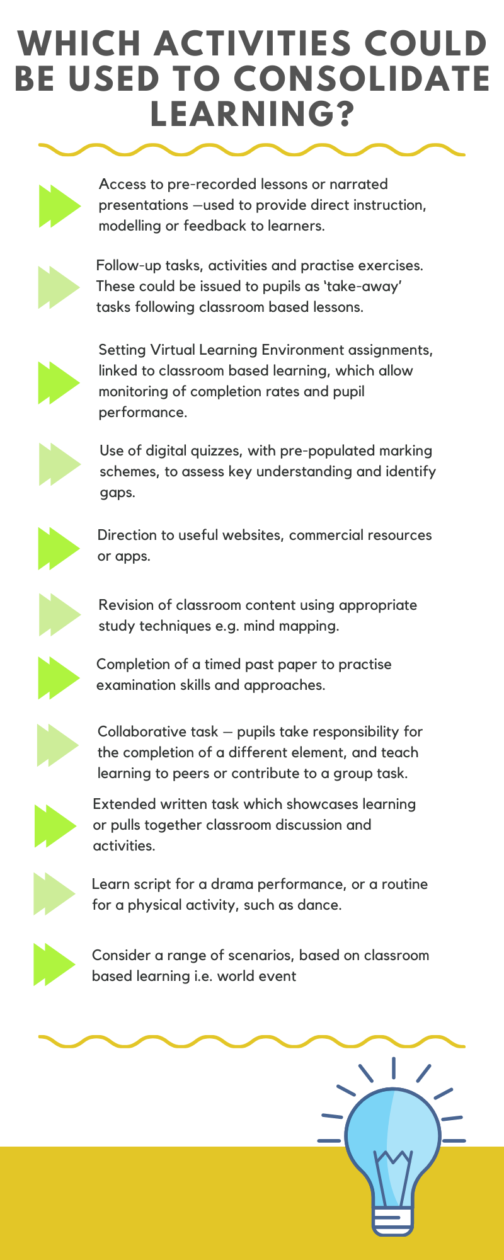
Primary

Planning and Organising Learning
Blended Learning can play a vital role in maintaining education provision and supporting Falkirk’s children and young people at this time. Teacher planning ensures that the right content and experiences are delivered in the best possible way in each setting.
There should be a clear purpose to every learning experience; effective planning is required to design the content and structure of activities to ensure these meet learning objectives.
Activities can be online, paper based or practical. Teachers will consider which methods will work best with different elements of the curriculum and in each context.
Not all at home learning needs to be digital, but effective use should be made of virtual learning platforms such as Microsoft Teams, Google Classroom or Seesaw. Whichever platform is used, this should be appropriately incorporated into learning and teaching processes within school and home activities to support all types of learning.
Blended learning experiences may look different depending on the stage of the child and reflects how children learn and develop at that stage. There is no formula for the correct balance of activities, and planning must consider the needs of students, the curriculum and available resources. However, consideration should be given to key learning in Literacy, Numeracy and Health and Wellbeing. It should also ensure that children continue to progress in their learning.
Many factors, including the age and stage of pupils, the curricular areas being taught, and the readiness of pupils and staff for using various technologies, will need to be considered before the best approach to blended learning is decided upon. It will not be the same for every child in every school for every stage.

Accessibility and Personalised learning
When planning blended learning approaches, consideration is given to how pupils access learning, opportunities to personalise learning and the needs of groups and individuals.
- In planning a blended learning approach, there should be a clear focus on wellbeing and good mental health. Schools should ensure that identified supports are accessible and understood by all.
- Blended learning approaches provide an opportunity to personalise learning for individuals and groups of learners. Learners can be directed to different activities to reinforce, extend and consolidate learning.
- Alongside supports and resources, activities can be differentiated to meet the needs of learners. These should support and build on learning within the classroom.
- Teachers must consider accessibility in planning learning activities for all learners: access to digital technology, appropriate materials and resources, access to parental support etc.
- Some parents and learners may require access to additional digital support, such as help guides.

Strategies for Blended Learning
Blended learning involves a combination of live timed interactions between the teacher and learners, opportunities for independent learning and activities which consolidate, extend and enhance learning. Our Blended Learning staff section has some examples of effective live timed interactions, but is by no means an exhaustive list and many are inter-changeable.
There are a variety of ways live timed interactions can happen. ‘Live timed interaction’ does not just mean ‘live video meetings’. The method of live timed interaction will vary depending on the contexts for Blended Learning –
- Self-isolation (Positive test/Track & Trace /Quarantine)
- Partial closure or whole class isolating
- Full school closure

Communication
Staff, learners and families are clear of blended learning approaches and the expectations of engagement. School should share any safeguarding practices for online learning.
Every effort will be made to encourage children and families to engage and provide support where necessary.

Partnerships
Schools work in partnership with others to provide a wider range of experiences and opportunities for learners. These may include:
- National e-Learning Offer – e-Sgoil (live interactive lessons for learners within BGE and Senior Phase)
- Education Scotland – Scotland Learns, curriculum support and recorded webinars
- Service and School Improvement Team
- Curriculum Support Team
- Falkirk Community Trust Outdoor Learning Team
- Active Schools
- Community Learning and Development
- Children’s Services
- Health Services

Secondary

Planning and Organising Learning
Blended learning combines classroom experiences with at home learning. Teacher planning ensures that the right content and experiences are delivered in the best possible way in each setting.
- There should be a clear purpose to every learning experience; effective planning is required to design the content and structure of activities to ensure these meet learning objectives.
- In a blended approach, learning becomes broken into two separate blocks: asynchronous and synchronous learning.
-
-
- Asynchronous learning allows learners to engage in learning activities and access resources at different times, usually out with the classroom. Activities are often used to introduce new concepts of learning, practise new/prior learning or allow pupils to reflect on their learning.
- Synchronous learning allows teachers and pupils to work together in person or online in real time. Activities allow teachers to easily question learners, facilitate discussion or to explain complex theories.
-
Effective blended learning requires the careful planning of both synchronous and asynchronous activities. Teachers will consider which methods will work best with different elements of the curriculum, and in each context.
- Not all at home learning needs to be digital, but effective use should be made of virtual learning platforms such as Microsoft Teams, Google Classroom or Apple Classroom. Whichever platform is used, this should be appropriately incorporated into learning and teaching processes within school and home activities to support both synchronous and asynchronous learning.
- There is no formula for the correct balance of activities, and planning must consider the needs of students, the curriculum and available resources. Many factors, including the age and stage of pupils, the subject and topics being taught, and the readiness of pupils and staff for using various technologies, will need to be considered before the best approach to blended learning is decided upon. It will not be the same for every child in every school for every subject.
Accessibility and Personalised learning
When planning blended learning approaches, consideration is given to how pupils access learning opportunities, opportunities to personalise learning and the needs of groups and individuals.
- In planning a blended learning approach, there should be a clear focus on wellbeing and good mental health. Schools should ensure that identified supports are accessible and understood by all.
- Blended learning approaches provide an opportunity to personalise learning for individuals and groups of learners. Learners can be directed to different activities to reinforce, extend and consolidate learning through asynchronous activities.
- Alongside supports and resources, activities can be differentiated to meet the needs of learners. These should support and build on learning within the classroom.
- Teachers must consider accessibility in planning learning activities for all learners: access to digital technology, appropriate materials and resources, quiet study area etc
- Some learners may require access to additional digital support, such as a technician.

Strategies for Blended Learning
Blended learning involves a combination of live interactions between the teacher and learners, opportunities for independent learning and activities which consolidate, extend and enhance learning. Below are some examples, but by no means an exhaustive list and many are inter-changeable.
Communication
Staff, learners and families are clear of blended learning approaches and the expectations of engagement within each setting. This will of course look different across ELC, Primary, ASN and Secondary..
- Pupils understand rules for interactions using VLEs – distraction free, raising hand etc.
- Tasks and instructions are easily understood, with a clear indication of how long activities should take and when work should be submitted for feedback.
- Teachers make effective use of calendars/ timelines to allow learners to pace themselves and catch up if they are off.
- Schedule of learning is shared with learners, to allow pupils to manage their time more effectively, particularly if they are working across a range of subject areas or with multiple teachers.
- Learners are clear that there will be opportunities for live interactions with staff. Planned alternatives are available for those who are unable to join these at specific times.
- Recorded lessons are well paced, and explanations are clearly understood. Learners are given enough thinking time within tasks, encouraged to pause recordings to think about something or do a particular task.
- Learners are aware of the purpose of their learning.
- Recorded lessons explicitly link the recorded lesson to ongoing classroom based work, signposting what has come before and after it e.g. when we are back in the classroom we’ll be moving onto X topic, so we will need to know this…
- Schools have clear safeguarding policies and practices in place for online learning.
Partnerships
ELC’s and schools work in partnership with others to provide a wider range of experiences and opportunities for learners. These may include:
- Community and third sector – youth work, culture and sport, community trust – outdoor learning and active schools, YMI
- National e-Learning Offer – e-Sgoil (live interactive lessons for learners within BGE (P1-S3) and Senior Phase (S4-6)
- Education Scotland – Scotland Learns, curriculum support and recorded webinars
For learners within the Senior Phase, leaners may continue to work on Consortia options as part of a blended learning model across Falkirk schools. Host schools will confirm arrangements directly with learners, using existing VLE platforms.
Forth Valley College opportunities will continue to run using a blended learning approach, already in place and operational across Falkirk schools.

ELC
Blended learning experiences for young children may look different to that of primary and secondary schools mainly on account of how children learn and develop at that stage. For young children, blended learning will involve play experiences that are led by the child and which follow their interest or ideas.
To support this, ELC settings will signpost play based learning ideas and opportunities for families. There is no right or wrong way to be involved in these ideas but often the best ideas are the ones that are formed around every day experiences such as: baking & cooking, daily routines; being outdoors. It is important that children experience a broad range of experiences between home and their ELC setting, so in a blended learning situation, settings may lend out the resources that children usually play with at nursery for use at home, for example, games, paints, learning objects.
These ideas and opportunities will be shared with families through various media platforms such as: Twitter, YouTube, email or online journals.
In a blended learning situation, it is important that there is continuity of support for children and families, for example, for additional support needs. ELC settings will continue to liaise with partner agencies and services so that support continues, wherever possible.

ASN

Planning and Organising Learning
Blended learning combines classroom experiences with at home learning. Teacher planning ensures that the right content and experiences are delivered in the best possible way in each setting.
- There should be a clear purpose to every learning experience; effective planning is required to design the content and structure of activities to ensure these meet learning objectives.
- In a blended approach, learning becomes broken into two separate blocks: asynchronous and synchronous learning.
-
-
- Asynchronous learning allows learners to engage in learning activities and access resources at different times, usually out with the classroom. Activities are often used to introduce new concepts of learning, practise new/prior learning or allow pupils to reflect on their learning.
- Synchronous learning allows teachers and pupils to work together in person or online in real time. Activities allow teachers to easily question learners, facilitate discussion or to explain complex theories.
-
Effective blended learning requires the careful planning of both synchronous and asynchronous activities. Teachers will consider which methods will work best with different elements of the curriculum, and in each context.
- Not all at home learning needs to be digital, but effective use should be made of virtual learning platforms such as Microsoft Teams, Google Classroom or Apple Classroom. Whichever platform is used, this should be appropriately incorporated into learning and teaching processes within school and home activities to support both synchronous and asynchronous learning.
- There is no formula for the correct balance of activities, and planning must consider the needs of students, the curriculum and available resources. Many factors, including the age and stage of pupils, the subject and topics being taught, and the readiness of pupils and staff for using various technologies, will need to be considered before the best approach to blended learning is decided upon. It will not be the same for every child in every school for every subject.
Accessibility and Personalised learning
When planning blended learning approaches, consideration is given to how pupils access learning opportunities, opportunities to personalise learning and the needs of groups and individuals.
- In planning a blended learning approach, there should be a clear focus on wellbeing and good mental health. Schools should ensure that identified supports are accessible and understood by all.
- Blended learning approaches provide an opportunity to personalise learning for individuals and groups of learners. Learners can be directed to different activities to reinforce, extend and consolidate learning through asynchronous activities.
- Alongside supports and resources, activities can be differentiated to meet the needs of learners. These should support and build on learning within the classroom.
- Teachers must consider accessibility in planning learning activities for all learners: access to digital technology, appropriate materials and resources, quiet study area etc
- Some learners may require access to additional digital support, such as a technician.

Strategies for Blended Learning
Blended learning involves a combination of live interactions between the teacher and learners, opportunities for independent learning and activities which consolidate, extend and enhance learning. Below are some examples, but by no means an exhaustive list and many are inter-changeable.
Strategies for ASN pupils who do NOT need adult directed learning:
Strategies for pupils who NEED adult directed learning:
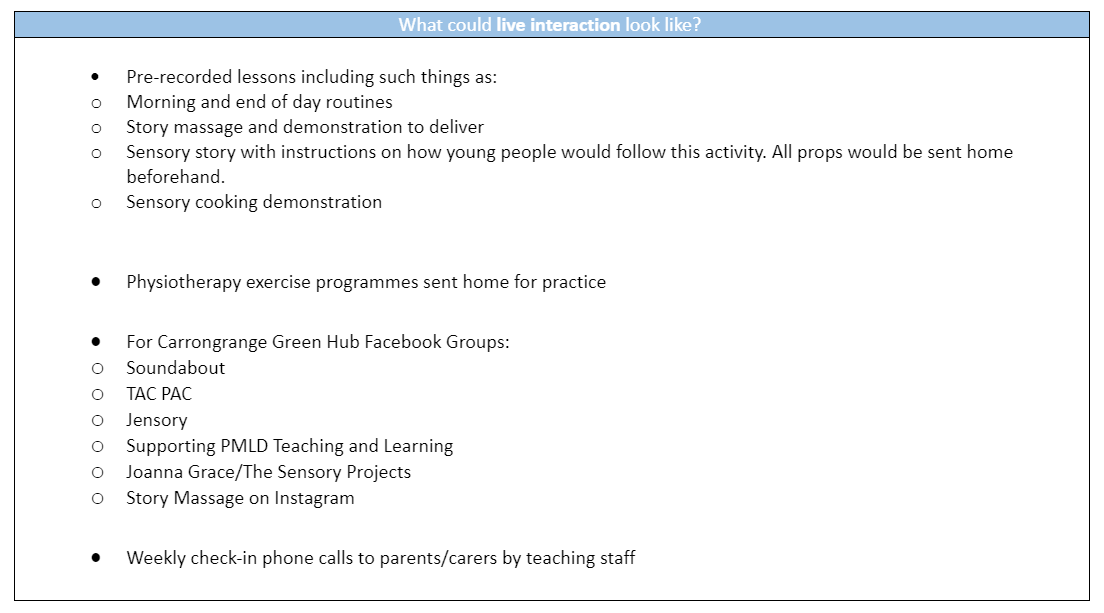
Communication
Staff, learners and families are clear of blended learning approaches and the expectations of engagement.
Staff, learners and families are clear of blended learning approaches and the expectations of engagement.
- Pupils understand rules for interactions using VLEs – distraction free, raising hand etc.
- Tasks and instructions are easily understood, with a clear indication of how long activities should take and when work should be submitted for feedback.
- Teachers make effectives use of calendars/ timelines to allow learners to pace themselves and catch up if they are off.
- Learning plans are shared with learners, to allow pupils to manage their time more effectively, particularly if they are working across a range of subject areas or with multiple teachers.
- Learners are clear of time specific opportunities for live interactions. Planned alternatives are available for those who are unable to join these are specific times.
- Recorded lessons are well paced, and explanations are clearly understood. Students are given enough thinking time within tasks, encouraged to pause recordings to think about something or do a particular task. For example, a videoed lesson relies on pupils being very proactive rather than passive.
- Students are aware of the purpose of their learning.
- Recorded lessons explicitly link the recorded lesson to ongoing classroom based work, signposting what has come before and after it e.g. when we are back in the classroom we’ll be moving onto X topic, so we will need to know this…
- Schools have clear safeguarding policies and practices in place for online learning
-
- Cameras trained on teacher or just on the board with the teacher’s voice.
- Pupils should not be visible on screen, and pupils’ cameras should be visible only to the teacher.
- Microphones should not be audible to each other unless the teachers deems it necessary
- Be clear about which lessons are recorded and their purpose.
- Parents and pupils should be clear of procedures.
- Expectations should be raised with pupils and their families.
- Pupils and their parents should agree not to record of share any element of live lessons.
- Consequences for such behaviours should be clear.
- Weekly check-ins by class teacher or pastoral staff to parents/carers.
-
Partnerships
Schools work in partnership with others to provide a wider range of experiences and opportunities for learners. These may include:
- Community and third sector – youth work, culture and sport
- National e-Learning Offer – e-Sgoil (live interactive lessons for learners within BGE and Senior Phase)
- Education Scotland – Scotland Learns, curriculum support and recorded webinars
- Do we continue to signpost offers here, or is this veering into the resources and support category?
For students within the Senior Phase, leaners may continue to work on Consortia options as part of a blended learning model across Falkirk schools. Host schools will confirm arrangements directly with learners, using existing VLE platforms.
Forth Valley College opportunities will continue to run using a blended learning approach, already in place and operational across Falkirk schools.



